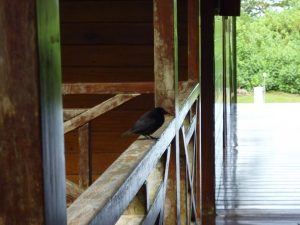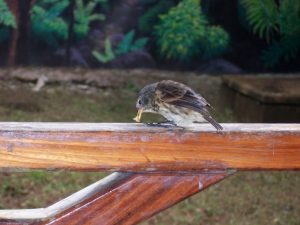The mid-afternoon and mid-morning coffee break at the Wafer Bay Station: sipping rich, hot coffee and eating a packet of cream-stuffed cookies, watching the three or four Cocos finches, twitter around the porch rafters and railings, lurking in hopes of crumbs. It was part of the daily ritual: sit down for coffee, and within five minutes the finches would appear, hopping closer and closer to the open packet of cookies before a warning hand would shoo them away. The finches have a fairly ordinary appearance, and an ignorant birder like me could easily label them a kind of sparrow, and dismiss them as a common songbird.
But the Cocos Island Finch, Pinaroloxias inornata, is no ordinary bird. Though indeed of the family Emerizidae, which also includes buntings and American sparrows, the Cocos Finch is unique in the world, found only on the 23.85 square kilometers of Cocos Island. Wikipedia calls it the thirteenth of Darwin’s finches, the only one not found on the Galapagos Islands.
The males are a shimmering coal black, and the females are a tabby, streaked brown. Usually 12 cm. from beak tip to tail, with a wingspan of 18 cm, these birds weigh between 12-16 grams. They are foragers, feeding on a highly varied diet of seeds, insects, crustaceans, fruits, and small lizards (and the occasional packaged cookie crumb). They breed most heavily between January and May, typically incubating two brown-speckled white eggs for 12 days in spherical nests suspended in tree branches. The finches thrive in all the habitats of the island, and they have proven to be fairly resistant to habitat disruptions, such as the introduction of cats, rats, and pigs to the island.
That being said, they are still classified as Vulnerable on the International Union for Conservation of Nature’s Red List of Threatened Species, due to the fact that the population of 10,000 to 20,000 is limited to such a small geographic area.






